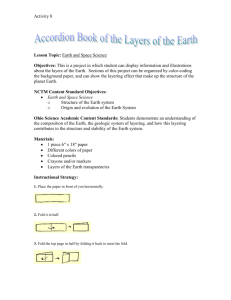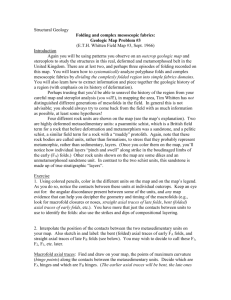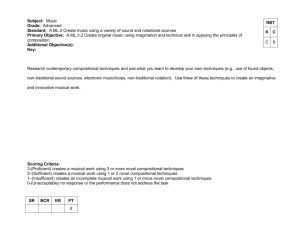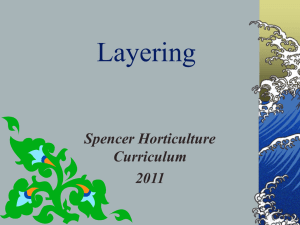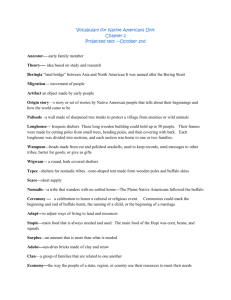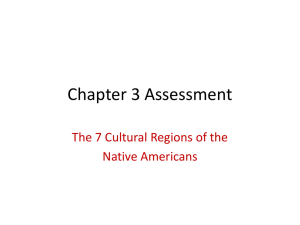Simple fabrics - Cloudfront.net
advertisement
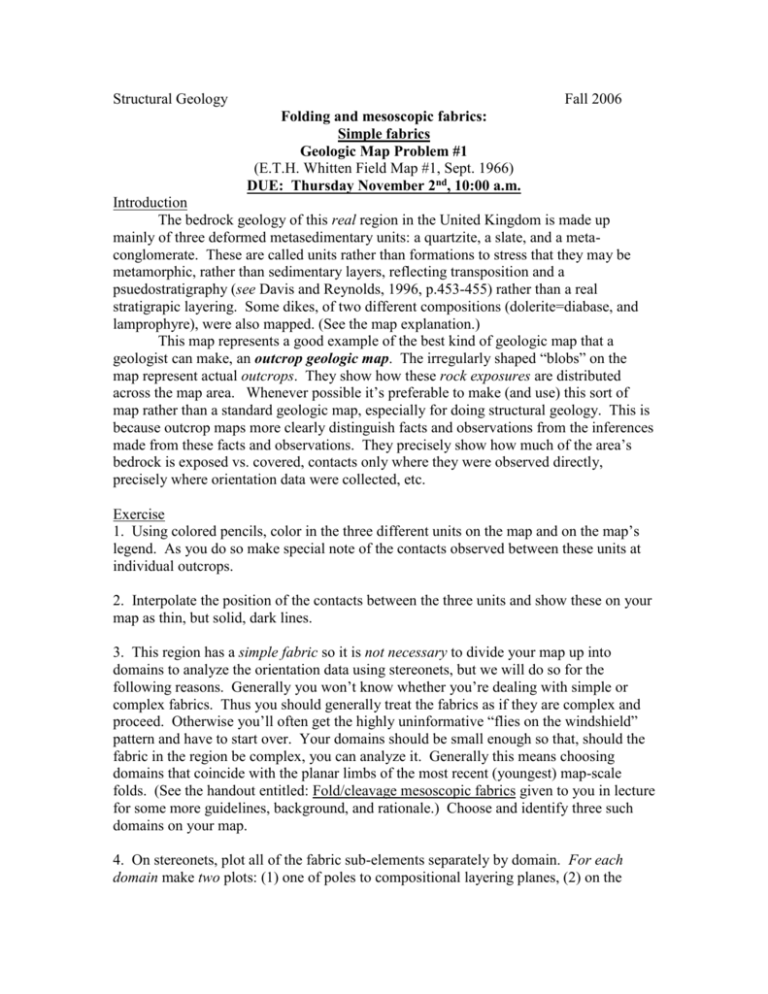
Structural Geology Fall 2006 Folding and mesoscopic fabrics: Simple fabrics Geologic Map Problem #1 (E.T.H. Whitten Field Map #1, Sept. 1966) DUE: Thursday November 2nd, 10:00 a.m. Introduction The bedrock geology of this real region in the United Kingdom is made up mainly of three deformed metasedimentary units: a quartzite, a slate, and a metaconglomerate. These are called units rather than formations to stress that they may be metamorphic, rather than sedimentary layers, reflecting transposition and a psuedostratigraphy (see Davis and Reynolds, 1996, p.453-455) rather than a real stratigrapic layering. Some dikes, of two different compositions (dolerite=diabase, and lamprophyre), were also mapped. (See the map explanation.) This map represents a good example of the best kind of geologic map that a geologist can make, an outcrop geologic map. The irregularly shaped “blobs” on the map represent actual outcrops. They show how these rock exposures are distributed across the map area. Whenever possible it’s preferable to make (and use) this sort of map rather than a standard geologic map, especially for doing structural geology. This is because outcrop maps more clearly distinguish facts and observations from the inferences made from these facts and observations. They precisely show how much of the area’s bedrock is exposed vs. covered, contacts only where they were observed directly, precisely where orientation data were collected, etc. Exercise 1. Using colored pencils, color in the three different units on the map and on the map’s legend. As you do so make special note of the contacts observed between these units at individual outcrops. 2. Interpolate the position of the contacts between the three units and show these on your map as thin, but solid, dark lines. 3. This region has a simple fabric so it is not necessary to divide your map up into domains to analyze the orientation data using stereonets, but we will do so for the following reasons. Generally you won’t know whether you’re dealing with simple or complex fabrics. Thus you should generally treat the fabrics as if they are complex and proceed. Otherwise you’ll often get the highly uninformative “flies on the windshield” pattern and have to start over. Your domains should be small enough so that, should the fabric in the region be complex, you can analyze it. Generally this means choosing domains that coincide with the planar limbs of the most recent (youngest) map-scale folds. (See the handout entitled: Fold/cleavage mesoscopic fabrics given to you in lecture for some more guidelines, background, and rationale.) Choose and identify three such domains on your map. 4. On stereonets, plot all of the fabric sub-elements separately by domain. For each domain make two plots: (1) one of poles to compositional layering planes, (2) on the second plot all of the other fabric subelements (i.e., mesofold axes, poles to foliation planes, poles to joint surfaces, poles to dikes). It may be most efficient to first make a data list for each domain, then plot the data. Please use the following “standard” symbols on your stereoplots: a) Using the data on each of your pole to compositional layering stereoplots, determine and show (as dashed lines on your stereoplots) -girdles. You can only do this if the folding in each domain is cylindrical (or subcylindrical). Is it? Explain why your poles cluster as they do in each domain, and why the orientation (plunge, trend) of the cluster varies from domain to domain. Are the cluster orientations the same for any of the domains? Explain why. b) Using the -girdles you drew above, construct and show on your stereoplots of poles to compositional layering, the fold axes () of the folded compositional layering surfaces. Does the orientation of the s differ greatly from domain to domain? Or are they all basically parallel? How do their orientations compare to those of the mesofold axes in each domain? Does this corroborate the claim that this region has a simple fabric? How? c) Find and draw on your map, the points of maximum curvature (hinge points) of the contacts between the three units that you interpolated and drew above. Connect the dots for individual macrofolds. Using a protractor, measure the trends of these lines, which are axial traces. Assume that on average the surface here is flat (horizontal). What’s then the plunge of the axial traces? d) Plot an average of these axial traces on your pole to compositional layering stereoplots. Using them and your statistical fold axes (), determine the orientation (strike/dip/dip direction) of the axial surfaces for each of the macrofolds. Draw these as solid great circles on your stereoplots. Also determine and show on your stereoplots the poles to these axial surfaces. What are their orientations? Do they differ greatly from domain to domain? Or are they basically all parallel? How do their orientations compare to those of the foliations in each domain? 5. Plot a summary, or synoptic, stereoplot showing all (except poles to compositional layering) fabric subelements for the entire region (i.e., s mesofold axespoles to macrofold axial planes, poles to foliations, poles to joint surfaces and dikes). a) Assuming a flat topographic surface, draw a cross-section through the map area oriented perpendicular to the major fold axes. You may wish to do so using the downplunge projection technique. Color layers in your cross section in using the same colors you used on the map. Show the fold axial traces on your cross-section and use them to help you define macrofold shapes and draw the macrofolds accurately. b) Interpret the structures of the region and their sequence of formation. Write-up a brief narrative. Include a brief discussion on what sort of additional mesoscopic and microscopic data you would need to distinguish whether the compositional layering in the region represents a transposed metamorphic layering and psuedostratigraphy (see Davis and Reynolds, 1996, p.453-455), or a true stratigraphy. Also, how would your interpretation of the structures of the region and their sequence of formation differ in each of these two scenarios? c) Interpret the relation of the foliation to the macroscopic folds, and of the sto the mesofold axes. Justify the statement given earlier that the mesoscopic fabric of the region is simple (use your answers from #4b and #4d to guide you)? Explain.

